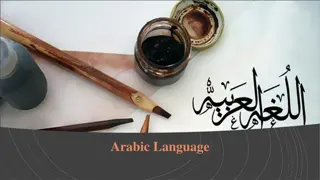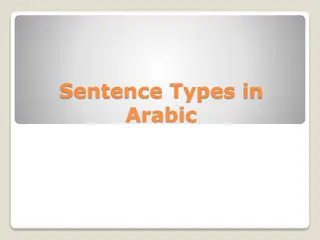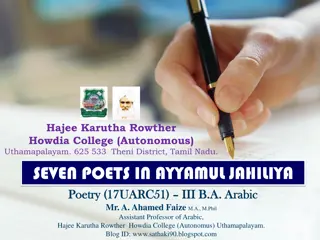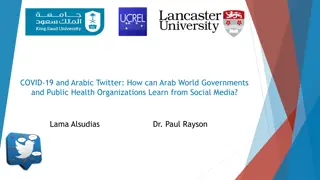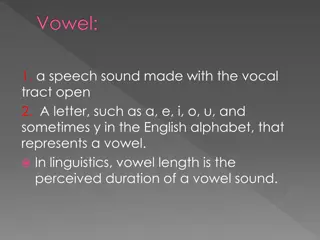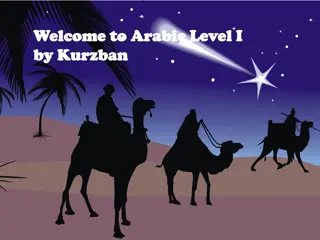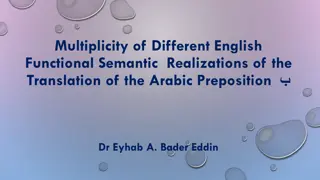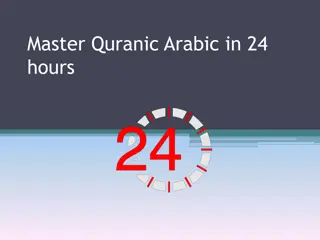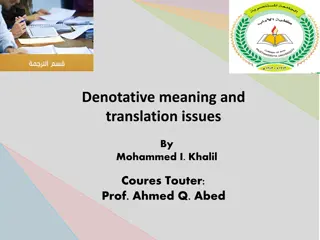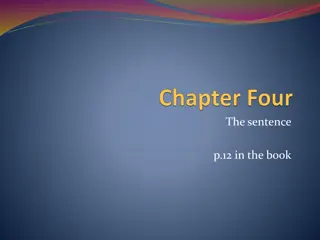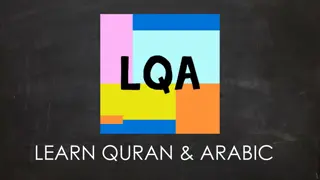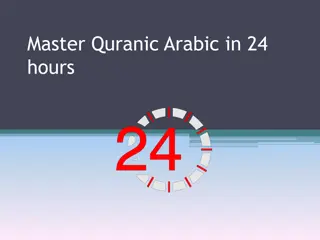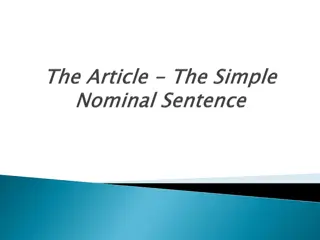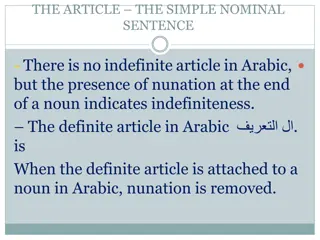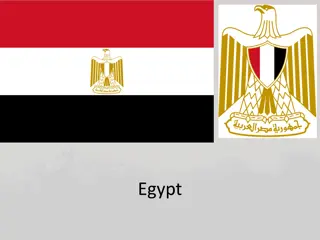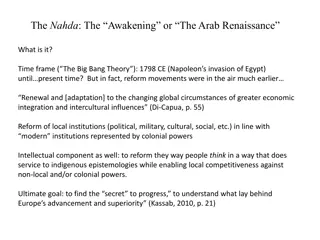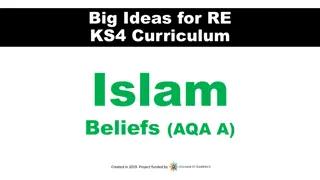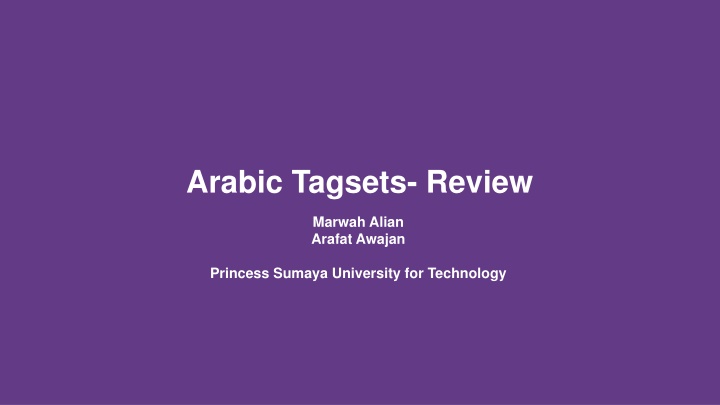
Arabic Language Tagsets in NLP Research
Dive into the realm of Arabic tagsets and their significance in NLP research. Explore the distinctions between Classical Arabic and Modern Standard Arabic, various tagsets proposed for Arabic, and their implementations and limitations in the NLP community.
Uploaded on | 0 Views
Download Presentation

Please find below an Image/Link to download the presentation.
The content on the website is provided AS IS for your information and personal use only. It may not be sold, licensed, or shared on other websites without obtaining consent from the author. If you encounter any issues during the download, it is possible that the publisher has removed the file from their server.
You are allowed to download the files provided on this website for personal or commercial use, subject to the condition that they are used lawfully. All files are the property of their respective owners.
The content on the website is provided AS IS for your information and personal use only. It may not be sold, licensed, or shared on other websites without obtaining consent from the author.
E N D
Presentation Transcript
Arabic Tagsets- Review Marwah Alian Arafat Awajan Princess Sumaya University for Technology
What is a Tagset? A tagset is a set of tags (symbols) representing information about parts of speech and about values of grammatical categories (case, gender, etc.) of word forms. A tagset is the basis of almost all NLP fields. A good tagset is very important in the fields of NLP and it is the foundation stone in these fields. simplicity of the POS tagset is intended to speed up human annotation and maintain the most important distinctions.
Arabic Language Categories Classical Arabic (CA) Modern Standard Arabic (MSA) In Classical Arabic words have diacritical marks which solve the ambiguity in the language. CA has less ambiguity than MSA. Modern Standard Arabic is the written language of contemporary literature, journalism, most of books, etc. MSA is a descendant of CA and retains the basic syntactic MSA is highly ambiguous which results from removing diacritical marks from writing.
Tagsets and NLP community Tagsets received a lot of intention of NLP community. In general they are well defined and implemented for English and Europe Languages. In the case of Arabic Language, a lot of tagsets are proposed but till now there is no well defined tagset and recognized by the community of NLP.
Main Tagsets for Arabic 2000-2004 El-Kareh and Al-Ansary Khoja Buckwalter Reduced Buckwalter tagsets BIES The Extended Reduced TagSet (ERTS) Penn Treebank: PATB 2006-2009 2010-2013 Salma Aliwy Alshamsi and Guessom ARBTAGS CATiB Yahya Elhadj
El-Kareh and Al-Ansary (2000) Description Limitations -words are classified into three main classes, Verbs, Noun and Particle. Each class is divided into subclasses, Verbs into 3 subclasses; Nouns into 46 subclasses and Particles into 23 subclasses.. - many of Arabic classes are not taken into account.
Khoja Tagset (2001) Description depends on ancient Arabic grammar to design a morphosyntactic tagset and she did not follow indo-European tagsets which depend on Latin. All subcategories in Khoja tag set are derived from the parent categories therefore the tagset hold language generalization. It has 177 tags.
Khoja Tagset (2001) Limitations The attribute person in noun class is a mistake here because the word book has no person Particles have no attributes. It is a very simple tagset, but many of Arabic classes are not taken into account.
Buckwalter Tagset (2002) Description It is considered very rich for many computational approaches. Several tagsets have been developed that reduce it to a manageable size. problems and 485 tags- untokenized Thousands tokenized
Buckwalter Tagset (2002) Limitations There is no distinction between categories and features for POS. The particle classification has no attributes. It does not distinguish between attached pronouns or other clitics and inflection of the word (suffixes).
Reduced Buckwalter Tagset BIES (2004) Description It has around 24 tags variants. It was inspired by the Penn English Treebank POS tagset.
Reduced Buckwalter Tagset BIES (2004) Limitations It is a very simple set which misses many useful features, in particular many classes of nouns, verbs and particles. The nouns, verbs and particles have no attributes.
Extended Reduced Buckwalter Tagset (2004) Description ERTS is the base tagset used in the Amira system. It has 72 tags. It is a subset of the full Buckwalter morphological set defined over tokenized text. Used in Amira system Added the explicit or marked morphological features of gender, number and definiteness on nominal.
Alshamsi and Guessom Tagset (2006) Description and Limitations -Specific for Name Entity -take into account the structure of Arabic sentence - It has 55 tags - Limited for Name Entity. Many classes are not consideration. taken into
ARBTAGS [Al-Qrainy] Tagset (2008) Description - Based on ancient Arabic grammar. - 101 nouns, 50 verbs, 9 particles, 1 punctuation - 161 detailed tags and 28 general tags
ARBTAGS [Al-Qrainy] Tagset (2008) Limitations - The attribute person in noun class is a mistake here because the word book has no person. - Particles have no attributes. - punctuations and foreign words are not covered
Penn Arabic Treebank (PATBPATB Tagset (2009) Description Limitations - With some kinds of words, the PATB morphology systematically fails to determine many of the contextual and lexical parameters - Follows Arabic traditional grammer. - tags specify details about word morphology such as definiteness, number, case, gender and mood. person, voice, - 2,000 combinations of 114 basic tags. tag types including
PADT Tagset Description - used in the ElixirFM analyzer, was developed for use in the Prague Arabic Dependency Treebank - Each tag consists of two parts: POS and Features.
PADT Tagset Limitations - It misses many classes and features. - Particles have no attributes.
Elhadj Tagset (2009) Description It can be used for analyzing and annotating traditional Arabic texts, especially the Quran text. The developed tagger employed an approach that morphological analysis with Hidden Markov Models (HMMs) combined three classes (Noun, Verb, Particl). .
Elhadj Tagset (2009) Limitations particles have no attributes. It is particularly simple with respect to verb and noun classifications. The case of noun was excluded which is very important in syntax analyses. It does not show any features for verbs and this is not a good choice, because Arabic verbs often have implicit pronouns and so on.
CATiB (2009) Description and Limitations There are only six POS tags in CATiB. It is the simplest tagset where many classes and features are missed.
Sawalha Tagset (Salma 2013) Description a tag consists of 22 characters; each position represents a feature and the letter at that location represents a value or attribute morphological feature; the dash - represents a feature not applicable to a given word. Sawalha tagset is not tied to a specific tagging algorithm or theory, and other tagsets could be mapped onto this standard . of the
Sawalha Tagset (2013) Limitations - This tagset neglects the variation of particles classification. Similarly as Khoja - It does not distinguish between working and meaning of particles - It is more theoretical than practical - It summarizes almost all the Arabic classifications, especially for verbs and nouns. some of the classifications (attributes) are useless (redundant) tags, for tagging system.
Aliwy Tagset (2013) Description The main tags in this tagset are Noun, Verb, Particle, Residual and Punctuation where Noun has 17 subclasses with Number, Gender, Structured. Verb class has three subclasses: Past (Pst), Present (Prt), Imperative (Imv). While verb attributes are: Gender,Number,Person, Mood, Certainty, Structured, and Voice. 3552 detailed tags and 45 main tags the features: Case and
Conclusion Marketing 1 Training 2 Assesment 3 Many reports about these tag sets do not give a detailed description for their design aspects. The existing tag sets have a limitation in covering all the features of Arabic language which leads to missing features. Available Arabic tag sets do not have a standard scheme for correlating each word to its morpheme and they join the tagging of both morphemes and words.
Conclusion Marketing 4 Training 5 Assesment 6 A number of tagging systems involve a small number of tags that gives a narrow view about the text and they do not explain more about particles and verbs. Even though the tag sets with large number of tags are complete and efficient for advanced tasks, they look very hard to be predicted while small tag sets tend to be more predictable and appropriate for many applications. The analysis used for texts in designing existing tagsets do not cover all Arabic features and characteristics.

